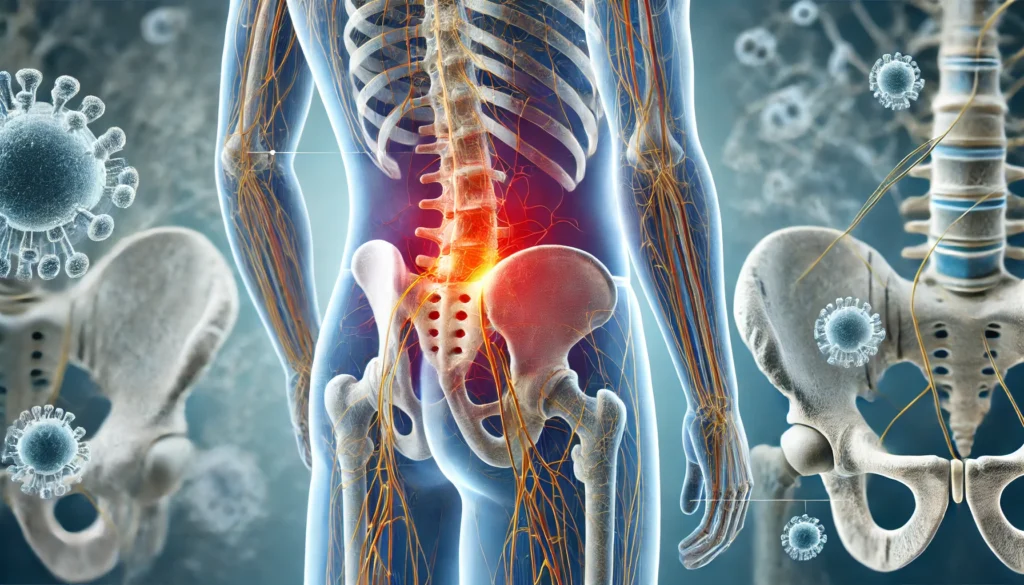Lower back pain that radiates to the front pelvic area is a common issue that many women experience. This type of pain can be particularly concerning as it affects daily activities and quality of life. Understanding the causes, symptoms, and treatment options is crucial for managing and alleviating this discomfort. In this article, we’ll explore the possible causes of lower back pain radiating to the front pelvic area in females, common symptoms, and effective treatment strategies.
What is Lower Back Pain That Radiates to the Front Pelvic Area?
Lower back pain that radiates to the front pelvic area typically refers to pain that starts in the lower back (lumbar region) and travels toward the front of the pelvis. This pain may range from mild to severe and can be sharp, aching, or throbbing. When pain radiates to the pelvic area, it may also involve the abdomen, groin, or thighs, making the discomfort more widespread.
For women, this type of pain can be particularly distressing, as it may be mistaken for menstrual cramps, pelvic infections, or other reproductive health issues. However, it’s essential to identify the underlying cause to find the appropriate treatment.
Read Also: Permanent Nerve Block for Back Pain – Long-Term Nerve Block for Back Pain Relief!
Common Causes of Lower Back Pain Radiating to the Pelvic Area in Women
There are several potential causes for lower back pain that radiates to the front pelvic area in women. Below are some of the most common factors:
1. Pelvic Dysfunction
Pelvic dysfunction occurs when the muscles, ligaments, or joints in the pelvic region are injured or misaligned. This dysfunction can lead to pain in both the lower back and pelvic area. Conditions such as sacroiliac joint dysfunction (SI joint dysfunction) or pelvic floor dysfunction can cause these symptoms.
2. Pregnancy-Related Pain
During pregnancy, a woman’s body undergoes various changes, including hormonal fluctuations and weight gain, which can put additional stress on the lower back and pelvic region. This can result in discomfort that radiates from the back to the front pelvic area, especially in the later stages of pregnancy.
3. Endometriosis
Endometriosis is a condition where tissue similar to the lining of the uterus grows outside the uterus. This can cause severe pelvic pain, especially during menstruation. The pain may radiate to the lower back, groin, or even the thighs, mimicking the sensation of lower back pain that extends into the pelvic area.
4. Ovarian Cysts
Ovarian cysts are fluid-filled sacs that develop on the ovaries. While many ovarian cysts are asymptomatic, larger cysts can cause discomfort in the lower back and pelvic area. The pain may radiate to the front of the pelvis, often intensifying during physical activity or intercourse.
5. Herniated Disc or Spinal Issues
A herniated or bulging disc in the lower spine can compress nerves, causing pain that radiates to different parts of the body. In some cases, this pain can travel to the pelvic area. Nerve compression in the lumbar spine, such as sciatica, may cause lower back pain that shoots down the legs and into the pelvic region.
6. Urinary Tract Infections (UTIs)
While UTIs are more commonly associated with pain or discomfort during urination, in some cases, they can cause lower back pain that radiates to the front pelvic area. Women are more prone to urinary tract infections, and the pain may feel like a dull ache in the lower abdomen or pelvis.
Symptoms of Lower Back Pain Radiating to the Pelvic Area

The symptoms of lower back pain that radiates to the pelvic region can vary depending on the underlying cause. Some common symptoms include:
- Dull, aching, or sharp pain: This can range from mild to severe, depending on the cause.
- Pain in the abdomen or groin: The pain may move from the back to the front of the pelvic area, including the lower abdomen.
- Pain during certain activities: Activities like sitting for long periods, bending over, or lifting heavy objects may worsen the pain.
- Menstrual-like cramps: In conditions like endometriosis, the pain may feel similar to menstrual cramps, but it may also extend to the lower back and pelvis.
- Numbness or tingling: In cases of nerve compression, numbness or tingling sensations may be felt in the legs or pelvic region.
- Difficulty moving or bending: Severe pain can make it challenging to move freely or perform daily activities.
How to Diagnose the Cause of Radiating Back and Pelvic Pain
To diagnose the underlying cause of lower back pain that radiates to the front pelvic area, a healthcare provider will typically perform a combination of the following:
- Physical Exam: A physical exam helps assess muscle strength, flexibility, and joint movement to identify any musculoskeletal issues.
- Imaging Tests: X-rays, MRIs, or CT scans may be used to examine the spine, pelvis, and reproductive organs for any structural abnormalities, such as herniated discs or ovarian cysts.
- Pelvic Ultrasound: This can be helpful in identifying conditions such as ovarian cysts or uterine abnormalities.
- Blood Tests: Blood tests can check for infections or hormonal imbalances that might contribute to pain.
- Laparoscopy: In some cases, a laparoscopy may be performed to diagnose conditions like endometriosis.
Treatment Options for Lower Back Pain Radiating to the Pelvic Area in Women
The treatment for lower back pain radiating to the front pelvic area depends on the underlying cause. Some of the most common treatment approaches include:
1. Physical Therapy
Physical therapy is often recommended to strengthen muscles in the lower back and pelvic area, improve posture, and increase flexibility. Targeted exercises can help alleviate pain and prevent further injury.
2. Pain Medications
Over-the-counter pain relievers like ibuprofen or acetaminophen may provide relief from mild to moderate pain. For more severe pain, a doctor may prescribe stronger pain medications or muscle relaxants.
3. Heat or Cold Therapy
Applying heat or cold to the lower back or pelvic area can help reduce inflammation and relieve pain. A warm compress or heating pad may soothe stiff muscles, while a cold pack can help with inflammation.
4. Lifestyle Changes
Making lifestyle changes, such as maintaining a healthy weight, practicing good posture, and engaging in regular physical activity, can prevent or reduce the intensity of pain.
5. Surgical Intervention
In rare cases, when conservative treatments don’t provide relief, surgical intervention may be required. For example, surgery may be necessary for severe herniated discs, pelvic organ issues, or other structural abnormalities.
6. Medications for Underlying Conditions
For conditions such as endometriosis, hormonal therapy, or medications to shrink ovarian cysts, a healthcare provider may recommend specific treatments to address the root cause of the pain.
When to See a Doctor
If you experience persistent or severe lower back pain that radiates to the pelvic area, it’s essential to seek medical advice.
- Unexplained weight loss
- Fever or chills
- Difficulty urinating or blood in the urine
- Numbness or tingling in the legs or pelvic area
A healthcare provider will help determine the exact cause and recommend an appropriate treatment plan.
FAQs:
1 What causes lower back pain that radiates to the pelvic area in women?
Common causes include pelvic dysfunction, pregnancy-related changes, endometriosis, ovarian cysts, and spinal issues.
2 How can I treat lower back pain that radiates to the pelvic area?
Treatment may involve physical therapy, medications, heat or cold therapy, and lifestyle changes, depending on the underlying cause.
3 Is pregnancy a cause of lower back and pelvic pain?
Yes, hormonal changes and increased stress on the body during pregnancy can cause pain in the lower back and pelvic region.
4 When should I see a doctor for back and pelvic pain?
If the pain is persistent, severe, or associated with other symptoms like fever, difficulty urinating, or numbness, consult a doctor.
5 Can endometriosis cause lower back pain?
Yes, endometriosis can cause pelvic pain that radiates to the lower back, often during menstruation.
Conclusion:
Lower back pain that radiates to the front pelvic area is a common but often misunderstood condition in women. It can be caused by a variety of factors, including pelvic dysfunction, pregnancy-related changes, endometriosis, or spinal issues. By understanding the symptoms, causes, and treatment options, women can better manage this pain and improve their quality of life. If you experience persistent discomfort, it’s crucial to consult with a healthcare provider to identify the underlying cause and receive appropriate treatment.
Read More Relevant Article:
- Read Also: Car Accident Back Pain – Back Discomfort from a Car Accident!
- Read Also: How to Treat Menopause Back Pain – Effective Ways to Alleviate Menopause-Related Back Pain!
- Read Also: DBQ for Back Pain: A Comprehensive Guide for Veterans and Claimants – Disability Benefits Questionnaire (DBQ) for Back Pain!











